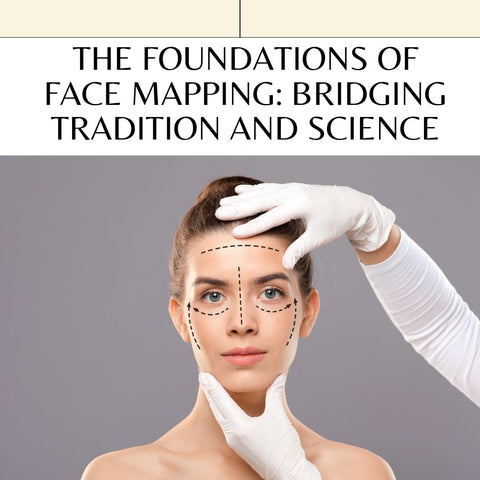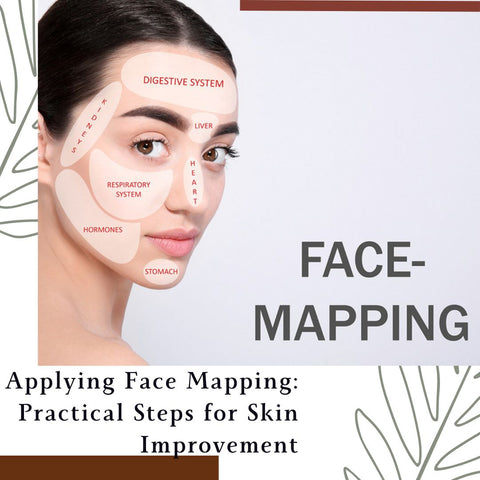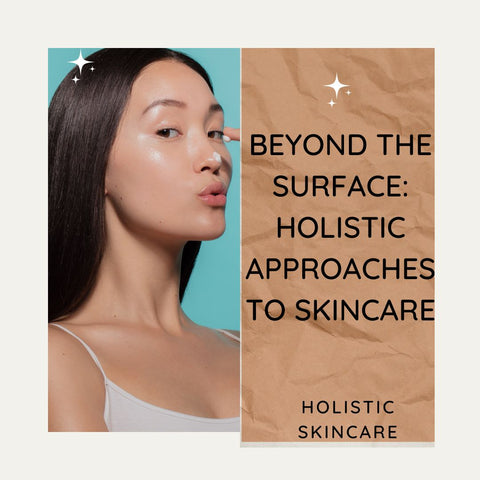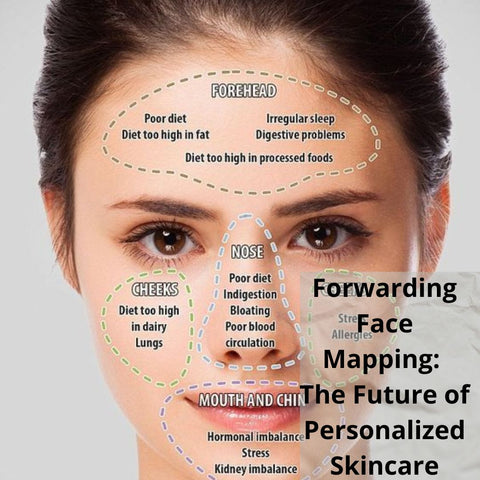"Face mapping," sometimes known as "facial mapping," is a comprehensive technique for understanding the relationship between the health of specific parts of the face and underlying imbalances or illnesses in the body. While face mapping is not a scientifically confirmed method, it is based on principles from traditional Chinese medicine, Ayurveda, and other holistic health systems that associate certain areas of the face with specific organs or systems in the body. This blog is about face mapping and its possible benefits for skin health.
The Foundations of Face Mapping: Bridging Tradition and Science

Face mapping, a notion rooted in traditional treatments such as Ayurveda and Chinese medicine, seeks to link facial characteristics to various elements of physical and mental health. While not scientifically proved, it provides a comprehensive framework for understanding potential imbalances in the body. This blog explores how face mapping combines tradition and science.
Unveiling the History: From Ancient Wisdom to Modern Practice
Face mapping is an ancient procedure with roots in traditional healing systems. Face mapping has grown as a holistic method of understanding the relationship between facial features and general health, beginning with ancient Ayurvedic and Chinese medicine and progressing to current interpretations.
-
Face mapping dates back to ancient medicinal practices such as Ayurveda in India and traditional Chinese medicine. According to Ayurveda, the face represents the balance of doshas (vata, pitta, and kapha) as well as the health of the respective organs and systems. Similarly, Chinese face mapping links facial zones to meridians and organ systems, with the idea that imbalances appear as skin problems or facial traits.
-
Throughout history, numerous societies have used face features to assess health, personality traits, and emotional states. Physiognomy, a practice used in ancient Greece and mediaeval Europe, linked facial characteristics to personality traits and fates.
-
Ayurvedic and Chinese medicine practitioners created elaborate maps that connect face zones to specific organs, meridians, and body systems. These systems regarded changes in facial appearance, such as pigmentation, texture, or blemishes, as indicators of internal imbalances or health issues.
-
Face mapping has become increasingly popular in current skincare and wellness techniques. While based on ancient wisdom, current face mapping incorporates scientific knowledge of skin physiology, psychology, and holistic health.
-
Many skincare specialists and holistic practitioners employ face mapping as a diagnostic tool to discover potential triggers or underlying health concerns that contribute to skin diseases. Face mapping encourages a holistic approach to skincare by emphasising the interdependence of physical, emotional, and environmental elements in skin health.
-
While face mapping provides a comprehensive view of health and fitness, its scientific validity has been questioned. Critics say that facial features differ widely between individuals, and that not all skin problems can be linked only to interior imbalances.
-
Despite its limits, face mapping encourages people to adopt personalised skincare and wellness habits based on their requirements and concerns. Face mapping improves general well-being and skin health by treating underlying imbalances and taking into account the mind-body link.
Understanding Zones: What Different Areas of Your Face Reveal
Face mapping links specific areas of the face to various internal organs, systems, or lifestyle factors, implying that changes in these areas may indicate underlying imbalances or health concerns. While not scientifically validated, here's a general overview of what different areas of the face are believed to reveal according to face mapping principles:
-
The forehead is frequently associated with the digestive system and bladder. Breakouts or congestion in this area could indicate digestive problems, dehydration, or a poor diet. Horizontal lines and furrows may indicate stress or tension.
-
The Third Eye Area, or "T-zone," is the region between the eyebrows and is connected to the liver and gallbladder. Redness or blemishes in this area could be a sign of digestive system imbalance or liver congestion. Here, emotional elements like repressed feelings, anger, or frustration may also show up.
-
The nose is associated with the heart and circulatory system. Redness, broken capillaries, or swelling could indicate poor circulation or cardiovascular problems. The tip of the nose may represent the heart, whereas the sides may represent the lungs.
-
Cheeks are associated with the respiratory system, lungs, and kidneys. Breakouts or redness on the cheeks may indicate respiratory problems, allergies, or kidney issues. Factors like pollution, smoking, or poor air quality may also affect this area.
-
The under-eye area is linked to the kidneys and adrenal glands. Dark circles, puffiness, or bags under the eyes could indicate kidney stress, dehydration, or adrenal fatigue. Lack of sleep, stress, or excessive caffeine consumption can all exacerbate under-eye problems.
-
Ears are associated with the kidneys and adrenal glands. Changes in ear colour, texture, or sensitivity could indicate a kidney or adrenal imbalance. Ears may also indicate an individual's ability to listen and process information emotionally.
-
The chin and jawline are linked to hormonal balance, reproductive organs, and the colon. Hormonal fluctuations, menstrual cycle irregularities, or digestive issues may cause breakouts, cysts, or acne in this area. Poor diet, stress, and hormonal medications can all exacerbate chin and jawline issues.
Integrating Dermatological Knowledge with Face Mapping Insights
Integrating dermatological knowledge with insights from face mapping can provide a more complete picture of skin health and potential imbalances. While face mapping is based on holistic principles, dermatology provides scientific insight into skin physiology, conditions, and treatments. Here's how these two methods can complement one another:
-
Skin Physiology: Dermatology provides a detailed understanding of skin anatomy, functions, and physiological processes. Integrating this knowledge with face mapping insights leads to a better understanding of how internal imbalances or health issues manifest on the skin's surface.
-
Skin Conditions: Dermatological expertise allows for the diagnosis and treatment of a variety of skin conditions using clinical signs, symptoms, and histopathological findings. To treat skin conditions holistically, dermatologists can use face mapping to identify possible triggers or contributing factors.
-
Internal-External Connections: Dermatology recognises the complex interplay of internal and external factors influencing skin health, such as genetics, lifestyle, environment, and systemic health conditions. Face mapping provides a framework for thinking about how internal imbalances or lifestyle choices may affect specific areas of the face and skin appearance.
-
Holistic Assessment: Integrating face mapping with dermatological assessments enables a more comprehensive assessment of skin health, taking into account both external manifestations and potential internal contributors. This comprehensive approach enables dermatologists to create personalised treatment plans that address underlying imbalances while focusing on specific skin concerns.
-
Patient-Centered Care: By combining dermatological expertise with face mapping insights, healthcare providers can provide patient-centered care that takes into account individual differences, preferences, and overall well-being. This approach encourages collaboration between patients and healthcare professionals, allowing people to take an active role in their skin health and overall well-being.
-
Research and Innovation: Integrating face mapping insights with dermatological research can lead to innovative approaches to skin health and treatment options. Researchers who investigate potential correlations between facial zones and internal health may discover novel biomarkers or therapeutic targets for skin conditions.
Applying Face Mapping: Practical Steps for Skin Improvement

Face mapping principles are used to promote skin health holistically, taking into account both internal and exterior elements impacting skin appearance. Here are some practical strategies for implementing face mapping into your skincare regimen, including self-assessment, lifestyle review, pattern identification, addressing underlying imbalances, focused skincare, gentle skincare, skin protection, progress monitoring, and seeking professional advice. By incorporating face mapping into your skincare routine and lifestyle habits, you may take a proactive approach to enhancing your skin's health and creating a bright complexion from the inside.
Decoding Your Skin's Signals: How to Read Your Face
Decoding your skin's signals entails observing and comprehending the messages that your face may be sending about your overall health and well-being. While not scientifically validated, face reading interprets facial features using traditional practices and holistic principles to identify potential imbalances or health concerns. Here's how to read your face:
-
Divide your face into different zones and observe the appearance of each area. Traditional face mapping charts may associate specific facial zones with corresponding organs, systems, or emotions.
-
Notice the texture of your skin in different areas of your face. Smooth, clear skin may indicate good health, while rough or uneven texture could suggest underlying imbalances.
-
Identify any signs of imbalance or disruption in specific facial zones, such as redness, inflammation, blemishes, dryness, or oiliness. Consider how these signs may relate to your overall health, lifestyle habits, or emotional state.
-
Pay attention to changes in your facial appearance over time, including new blemishes, wrinkles, lines, or discoloration. Changes in facial features or skin conditions may reflect shifts in your internal health or external environment.
-
Evaluate your lifestyle habits, including diet, hydration, sleep quality, stress levels, exercise, and skincare routine. Notice how these factors may be influencing the appearance of your skin and facial features.
-
Recognize the interconnectedness of the mind and body in skin health. Emotional states, stress, and mental well-being can impact facial expressions and skin conditions. Take note of any emotional or psychological factors that may be contributing to changes in your face.
-
Consult with dermatologists, skincare professionals, or holistic practitioners for personalized advice and treatment recommendations. Professionals can offer insights into your skin's unique needs and help address underlying imbalances or skin concerns.
-
Take a holistic approach to skincare and well-being, considering the mind-body connection and the interplay of internal and external factors. Adopt lifestyle practices and skincare routines that support overall health and promote balance within the body.
Tailored Skincare Strategies Based on Face Mapping
Tailoring skincare strategies based on face mapping entails tailoring your skincare routine to address specific concerns or imbalances identified in various facial zones. While not scientifically validated, face mapping offers a comprehensive framework for understanding how internal and external factors affect skin appearance. Here's how to create personalised skincare strategies using face mapping principles:
-
Identify Concern Areas: Use a face mapping chart or guide to identify areas of your face that may be out of balance or have specific skin concerns. Take note of any patterns or correlations between facial zones and possible underlying health issues or lifestyle factors.
-
Select Targeted Products: Choose skincare products that are designed to meet the unique needs of each facial zone identified through face mapping. Look for ingredients that are known to address common skin concerns in specific areas of the face, such as acne-fighting ingredients for blemish-prone areas or hydrating ingredients for dry areas.
-
Zone-Specific Treatments: Apply treatments or serums targeted to each facial zone based on its unique needs and concerns. For example, use spot treatments for blemishes on acne-prone areas or anti-aging serums for areas prone to fine lines and wrinkles.
-
Adjust Cleansing Techniques: Customize your cleansing routine based on the needs of different facial zones. Use gentle cleansers for sensitive areas and targeted treatments, such as exfoliating cleansers or oil cleansers, for areas prone to congestion or excess oil production.
-
Moisturize Accordingly: Use moisturizers formulated to address the specific hydration needs of each facial zone. Choose lightweight, non-comedogenic moisturizers for oily or acne-prone areas and richer, more emollient formulas for dry or dehydrated zones.
-
Protect with SPF: Apply broad-spectrum sunscreen daily to protect all facial zones from UV damage and premature aging. Choose lightweight, non-greasy sunscreen formulations suitable for all skin types and easily layered under makeup.
-
Consider Internal Factors: Address underlying imbalances or lifestyle factors that may be contributing to skin concerns observed through face mapping. Incorporate dietary changes, hydration, stress management techniques, and other holistic wellness practices to support overall skin health from within.
-
Monitor Progress: As you implement tailored skincare strategies based on face mapping, keep track of how your skin's appearance and texture change over time. Adjust your routine as needed to maximise results and address any new skin concerns or imbalances.
By tailoring your skincare routine to face mapping insights, you can address specific concerns or imbalances in various facial zones while also promoting overall skin health and balance. While face mapping provides a holistic approach to skincare, it is critical to supplement it with evidence-based skincare practices and consult with skincare professionals for personalised advice.
Diet, Lifestyle, and Their Impact on Your Skin’s Health Through Face Mapping
Diet and lifestyle have a significant impact on skin health, and their effects can be seen through face mapping, which links specific facial zones to corresponding organs or systems in the body. Understanding how diet and lifestyle choices affect different areas of the face allows you to make more informed decisions that promote overall skin health. Here's how diet and lifestyle affect your skin's health using face mapping: forehead, between the brows (third eye area), nose, cheeks, under-eye area, ear, chin, and jawline. You can improve the appearance and health of various facial zones by making conscious diet and lifestyle changes to support your digestive health, liver function, circulation, kidney function, adrenal health, and hormonal balance. A well-balanced diet rich in whole foods, staying hydrated, managing stress, regular exercise, prioritising sleep, and avoiding environmental toxins can all help to improve skin health. Furthermore, consulting with healthcare professionals or holistic practitioners can provide personalised advice and support for improving the health of your skin through diet and lifestyle changes.
Beyond the Surface: Holistic Approaches to Skincare

Holistic skincare approaches acknowledge that diet, lifestyle, emotional well-being, and environmental influences all have an impact on skin health. By addressing these factors holistically, you can improve your skin's overall health and vitality, as well as its appearance. The following are some holistic approaches to skincare that go beyond surface-level treatments:
-
Nutrition and Diet: Eat a well-balanced diet high in vitamins, minerals, antioxidants, and essential fatty acids to promote skin health from within. To help protect against oxidative stress and premature ageing, eat antioxidant-rich foods like fruits, vegetables, nuts, and seeds. Drink plenty of water and herbal teas to keep your skin hydrated and detoxified.
-
Lifestyle Choices: Stress can aggravate skin conditions and accelerate ageing, so manage it with practices such as meditation, yoga, deep breathing exercises, or spending time in nature. Regular exercise can improve circulation, detoxification, and overall well-being, all of which can lead to healthier skin. Prioritize sleep to allow your body time to repair and regenerate, as inadequate sleep can contribute to skin issues like dullness, fine lines, and dark circles.
-
Mind-Body Connection: Cultivate good emotions and self-care habits to promote emotional well-being, as mental and skin health are inextricably linked. Practice mindfulness and self-awareness to understand how emotions and stress affect your skin and general health. Consider holistic therapies such as aromatherapy, acupuncture, or energy healing to create balance and relaxation, which can help with skin health.
-
Toxin Reduction: Reduce exposure to environmental chemicals and pollutants, which can cause skin irritation, inflammation, and premature ageing. Choose natural, non-toxic skincare products that are free of harsh chemicals, perfumes, and synthetic ingredients that could upset the skin's natural equilibrium. Support your body's detoxification pathways with techniques such as dry brushing, sauna sessions, or occasional detox meals, all under the supervision of a healthcare expert.
-
Gut Health: Support gut health with probiotic-rich foods such as yoghurt, kefir, sauerkraut, and kombucha, as a healthy gut microbiome has been linked to cleaner, better skin. Consider consuming prebiotic foods such as garlic, onions, asparagus, and bananas to nurture good gut flora while also aiding digestion and nutrient absorption.
-
Individualized Care: Understand that skincare is not a one-size-fits-all solution; what works for one person may not work for another. Listen to your body and see how it reacts to various products, substances, and lifestyle changes to personalise your skincare routine to your specific requirements. Consult with skincare professionals, dermatologists, or holistic practitioners who can offer personalised advice and assistance for your skin issues.
The Role of Internal Health in Shaping Your Skin's Appearance
Internal health influences the appearance and health of your skin. The skin is more than just an outer covering; it also reflects your internal well-being. Several internal factors, such as diet, hydration, digestion, hormonal balance, immune function, and stress levels, can affect the condition, texture, and overall appearance of your skin. Here's how internal health affects skin appearance:
-
A well-balanced diet high in vitamins, minerals, antioxidants, and essential fatty acids promotes skin health by providing the necessary nutrients for repair, regeneration, and protection. Nutrient deficiencies or imbalances can cause dullness, dryness, acne, inflammation, and premature ageing of the skin.
-
Adequate hydration is critical for maintaining skin moisture, elasticity, and suppleness. Dehydration can cause dry, flaky skin, exacerbate fine lines and wrinkles, and compromise the skin's natural barrier function.
-
Constipation, bloating, and food sensitivities can all contribute to skin conditions like acne, eczema, or rosacea. A healthy gut microbiome supports digestion, nutrient absorption, and immune function, which in turn influences skin health.
-
Hormonal fluctuations, particularly during puberty, menstruation, pregnancy, or menopause, can affect oil production, leading to acne breakouts or changes in skin texture. Imbalances in hormones like cortisol, insulin, estrogen, or testosterone can influence skin conditions like acne, hyperpigmentation, or skin sensitivity.
-
A strong immune system helps defend the skin against pathogens, inflammation, and oxidative stress. Immune dysfunction or chronic inflammation can contribute to skin conditions like eczema, psoriasis, or dermatitis.
-
Chronic stress triggers the release of cortisol and other stress hormones, which can disrupt the skin's barrier function, increase oil production, and exacerbate skin conditions like acne or eczema. Stress management techniques like meditation, deep breathing, or yoga can help reduce stress levels and improve skin health.
-
Quality sleep is essential for skin repair, regeneration, and collagen production. Inadequate sleep can cause under-eye bags, dark circles, a dull complexion, and accelerated skin ageing.
-
Environmental pollutants, UV radiation, cigarette smoke, and other toxins can harm the skin, speed up the ageing process, and increase the risk of developing skin cancer. Antioxidants, found in fruits, vegetables, and skincare products, help to neutralise free radicals and protect the skin from environmental damage.
You can improve the appearance and vitality of your skin from the inside out by focusing on internal health with a balanced diet, proper hydration, digestive support, hormonal balance, stress management, restful sleep, and environmental protection. Consistency in healthy habits, combined with personalised skincare routines, can help to maintain radiant, glowing skin and promote long-term skin health.
Stress, Sleep, and Skincare: A Holistic View Through Face Mapping
Stress and sleep have a significant impact on both your internal health and your external appearance, and when viewed through the lens of face mapping, their impact on skincare becomes even clearer. Face mapping connects specific facial zones to corresponding organs or systems in the body, allowing us to identify sources of concern and potential imbalance. Here's a comprehensive look at stress, sleep, and skincare using face mapping of the forehead, between the brows (third eye area), nose, cheeks, under-eye area, ears, chin, and jawline. By using face mapping to identify the interplay between stress, sleep, and skincare, you can take a holistic approach to skincare that addresses both internal imbalances and external manifestations. Prioritizing stress management techniques, improving sleep quality, and following a personalised skincare routine can all contribute to overall skin health and vitality, promoting a radiant complexion from the inside out.
Embracing a Balanced Lifestyle for Optimal Skin Health
A balanced lifestyle is essential for maintaining good skin health because it promotes internal well-being, cellular regeneration, and strengthens the skin's natural defences. By incorporating healthy habits into your daily routine, you can nourish your body from within and achieve a glowing complexion. The following are key components of a balanced lifestyle for optimal skin health:
-
Nutrient-Rich Diet: Consume a variety of fruits, vegetables, whole grains, lean proteins, and healthy fats to get enough vitamins, minerals, antioxidants, and nutrients for your skin. Antioxidant-rich foods such as berries, leafy greens, nuts, and seeds can help combat oxidative stress and protect against premature ageing.
-
Hydration: Drink plenty of water throughout the day to keep your skin hydrated, promote detoxification, and improve elasticity. Hydrating alternatives to plain water include herbal teas, coconut water, and fruit or herb-infused water.
-
Regular Exercise: Engage in regular physical activity to improve circulation, promote lymphatic drainage, and support overall well-being. Activities like brisk walking, yoga, swimming, or strength training can enhance blood flow to the skin and promote a healthy complexion.
-
Stress Management: Practice stress-reduction techniques such as meditation, deep breathing exercises, mindfulness, or hobbies to minimize the impact of stress on skin health. Prioritize self-care activities that promote relaxation and emotional well-being, such as spending time in nature, journaling, or listening to calming music.
-
Quality Sleep: Aim for 7-9 hours of quality sleep each night to allow your body time to repair, regenerate, and replenish skin cells. Create a bedtime routine, limit screen time before bed, and create a comfortable sleep environment to promote restful sleep.
-
Skincare Routine: Establish a personalized skincare routine tailored to your skin type, concerns, and goals. Cleanse, exfoliate, moisturize, and protect your skin daily with high-quality skincare products containing beneficial ingredients like antioxidants, hyaluronic acid, and SPF.
-
Sun Protection: Every day, even on cloudy days, wear broad-spectrum sunscreen with SPF 30 or higher to protect your skin from UV damage. Seek shade, wear protective clothing, and avoid prolonged sun exposure during peak hours to reduce your chances of sunburn, premature ageing, and skin cancer.
-
Moderate Alcohol and Caffeine Consumption: Limit your alcohol and caffeine intake, as both can dehydrate your skin and exacerbate inflammation. Instead of caffeinated or alcoholic beverages, drink herbal teas, water, or fresh juices to stay hydrated.
-
Avoid Smoking and Environmental Toxins: Quit smoking and avoid secondhand smoke, as smoking causes premature ageing, impairs circulation, and damages collagen and elastin fibres in the skin. Reduce exposure to environmental pollutants, toxins, and chemicals that can cause skin irritation, inflammation, and premature ageing.
By adopting a balanced lifestyle that prioritises nutrition, hydration, exercise, stress management, quality sleep, skincare, sun protection, and healthy habits, you can improve your skin health and achieve a glowing complexion that reflects your overall well-being. Consistency, patience, and self-care are essential for maintaining vibrant, radiant skin over time.
Forwarding Face Mapping: The Future of Personalized Skincare

Face mapping has the potential to transform personalised skincare by revealing insights into the specific demands of different skin types and issues. As technology evolves and our understanding of skin physiology grows, face mapping will become ever more exact and individualised recommendations for skincare regimes. The future of personalised skincare holds promise for more effective, efficient, and targeted solutions to address individual skin challenges and attain optimal skin health. As these breakthroughs advance, consumers may expect increasingly personalised skincare experiences that address their requirements and preferences.
















